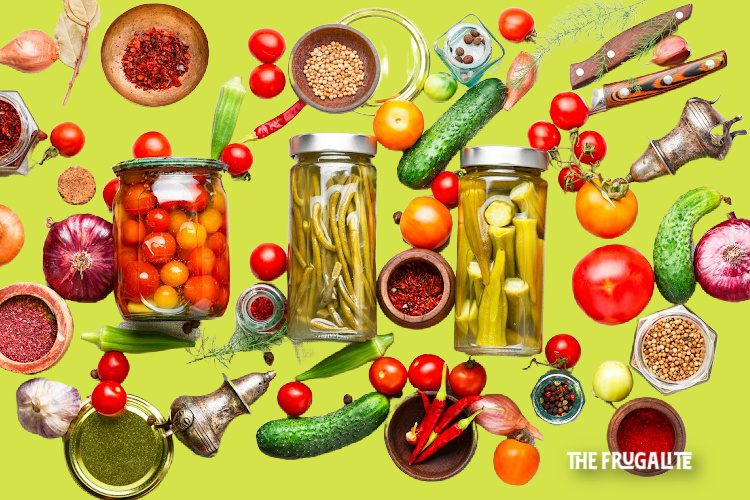(Psst: The FTC wants me to remind you that this website contains affiliate links. That means if you make a purchase from a link you click on, I might receive a small commission. This does not increase the price you’ll pay for that item nor does it decrease the awesomeness of the item. ~ Daisy)
By the author of the FREE online course Growing Self-Sufficiency: The Whole Picture
Whew! I just finished canning a bushel of Roma tomatoes (around 50 pounds). I did it in two days, half a bushel a day. Now that my beautiful Mason jars are all sitting quietly in their splendor, I thought I would share some of my best tips for frugal canning with the Frugalite community. Although you can save money with canning, I will be covering a number of different ways to “save,” including time, which is money, right?
You can save money by canning
Over the years, I have found various ways to save money while canning produce. In my own garden, although it is large, I generally focus on growing a variety of produce and don’t grow enough romas for canning. I find that I can save a ton of money by waiting patiently for the half-bushel flats to arrive in early harvest time, usually around the end of August here in Eastern Ontario, Canada.
My cost for a full bushel of beautiful romas this year was only $17.50. That will allow me to make a huge batch of chili once a month and a batch of stew or soup once a week, so it will come close to meeting my needs for canned tomatoes this winter. Other than growing it yourself, you can also save big on produce by connecting with nearby growers through the internet or your local farmer’s markets. You may be able to arrange for a delivery of a large volume of what you want for a great price.
Another expense of canning is those mason jars. I only buy the highest quality ones, made in the USA. I will not buy jars made in China! However, there are other ways to save on your jars. One way is to watch the sales throughout the year, and especially check clearance racks. Maybe one jar is damaged in the box of 12, but you may get the rest for a great price. One local woman who canned a lot placed an ad in the local buy and sell offering to buy peoples’ extra canning jars for around half the retail price. I would not have fallen for that particular offer, but it seemed, based on the comments to her ad, that many did! As well, our local thrift shop run by a church has canning jars for a deep discount.
By the way, if you happen to have an extra mason jar around, here are 31 fun uses for it!
You can save time by canning
There’s no question that canning takes time. However, I have found that by carefully planning how I can, I’m able to save a lot of time. For example, I used a large mason jar (1L) to can my tomatoes on the first day. This is the amount of tomatoes that I like to use in my huge chili batch. This allowed me to can half a bushel of tomatoes in just one batch of 6 jars, with two-pint jar portions left over and frozen to make soup, and one-pint jar portion that I made soup with right away. Compared to my second day, where I was making pint jars for soup, I saved a ton of time.
In what form you can your produce can either cost you or save you time. For example, back in the day, I was canning whole tomatoes and packing the jars with the water used to cook them. When I realized that I always wanted my tomatoes crushed, whether it be for chili or soup, I switched to canning crushed tomatoes. I find the crushed tomatoes easier to can and to add liquid to the fill level. I also prefer the texture of the crushed tomatoes, as there is no added water, just the juice of the tomatoes themselves.
You can save your back while canning
This past year, I have been dealing with some pretty serious issues with my back. For me, it is not a small consideration to try and save my back while getting my canning done. If I end up aggravating my back injury, it could mean lost wages on my other jobs or lost work on the homestead.
Here are some simple steps that I took to prevent back pain while getting 55 pounds of tomatoes done in 48 hours. On the first day, I prepared 22 pounds of tomatoes (washing, blanching, coring, and chopping into quarters) at one time. This turned out to be too much and I paid for it with pain by the end of the day, even though I was taking what I thought were good-sized breaks.
On the second day, I took the following steps: more small breaks in between steps, breaking the preparation of the tomatoes into two batches of 7-pint jars and having one foot up on a step during the preparation phase. Here is a demonstration of what this would look like: check out item number 3 on this link. I also combined an anti-fatigue mat with frequent changes of posture and some short walking to mix things up. I plan to write my next blog post on time-saving tips for canning.
You can save your mood by canning
I recall reading one homesteader’s blog where she referred to her annual canning activities as the “hell weekend.” While canning is hard work, I take many steps to make it as enjoyable as possible. I find that some years, I am more in the mood for canning, and some years, less so. I just go with that. This year is an up year, and I plan to make some extra salsas and experiment with water bath canning some of my delicious fermented pickles. If it’s very hot one year, or I’ve had other homestead challenges, I don’t push it. I want to enjoy everything I do. That’s why I’m here!
A few things that I do to make my canning days enjoyable are being very organized so I have everything on hand and ready to go, taking a break between the vegetable preparation process and the canning process, and having food available for a delicious cold plate for supper so I don’t have to be cooking on days I’m canning.
During the canning process, I can with reverence for the miracle of life and of food. I reflect on how fortunate I am to be able to do this. I believe in the Buddhist philosophy of enjoying the present moment, so I frequently take a deep breath and come back to the present moment. My shoulders are often tense, so I take that moment to relax them. I think about canning as if I am canning my attitude along with the vegetables, reflecting on what a treasure they are in our long, cold winters here in Canada. In this way, I can focus on gratitude and enjoyment during the often challenging work of canning.
What are some ways to make canning more enjoyable for you? Playing your favorite tunes? Have a friend take part? Involving your children?
I think I can, I think I can, I KNOW I can save!
You can do it: $ave while canning! Could you see yourself trying any of the “Can save” tips offered here? Do you have one of your own that you can share with us? What does canning help you save? Please tell us in the comments.
About Colette
Colette is passionate about sharing her knowledge of thrifty living and self-sufficiency. She has developed her skills in self-reliance living in the suburbs, the city, and more recently, on her own Half-Acre Homestead. Colette lived five years completely off-grid and without running water in an eight by 24 foot tiny home while designing and building her own 18 by 24-foot eco-cabin. Her website, Half Acre Homestead is attracting followers from around the world who want to become more self-sufficient. Colette invites you to stop by the Homestead and check out all of the great resources including the practical How To Guides, A Tiny Home Resource Center and her organic gardening stories on her blog. She shares her wholistic model (body/mind/spirit) for achieving self-sufficiency in her Free Course, “Growing Self-Sufficiency: The Whole Picture.” Stop by the Homestead today to register free of charge!











6 thoughts on “How to Save Time and Money When Canning”
When I was able to have a garden and canned, I would make lots of sweet relish from the cucumbers that “got away from me” which, of course, meant that I had missed them until they were too big and not as good for other uses. They still made good relish and it prevented waste.
Hi Mary, You know, I have never tried this before, but you have inspired me to try! I have several zucchinis that “got away from me.” I am going to search for some recipes to use them up and give it a try. I will post back when I’m finished and let you know how it went. Thanks so much for sharing, Mary! Wishing you a very enjoyable end of summer (this last little bit!)!
Hi Colette,
For people who do a lot of canning it is important to think of ways to streamline the process. The fall canning season is a marathon, not a sprint!! I really liked what you wrote about how to make it easier on our bodies.
Here are a few things our family (6 homeschooling boys… 4 of which are off and running, two still at home) has done:
– for jam we have frozen all kinds of fruit and then pulled the bags out in the winter or when it’s been raining for several days in the fall and need some kind of different and fun project … do a little math by doubling (or tripling) a batch of biscuits and now everyone is having fun! We always canned our jam in pint jars with a few smaller ones ready for what would not fill a pint… gave those smaller jars away.
-in the spring when cleaning out freezers we’d usually find “lost” bags of berries…I’d throw them all in a big pot and make pancake syrup…normally in quart jars. When we have grandparents or other family over for breakfast the boys pull out a jar …. very fancy!!
It’s been helpful to find ways to spread canning projects out throughout the year!
-Old Laying hens… did a lot when the boys were younger…. started off doing all the butchering, cleaning and canning in the same day. It was better to throw the clean chicken into ziplock bags in the freezer and then do it another day.
-If you can have some of what you are prepping for canning for supper the night you are canning or the next night, that feels pretty organized especially when you have a pack of hungry children running around:)
-when all my boys were home my canning was basic…. diced tomatoes, plain sauce, plain moose meat…. all ingredients I would use to make a meal. Recently I did some bbq chicken and moose in quart jars which added to some rice and salad would actually feed the four of us. When all six boys were home I would have had to use 3 quarts and that just was not worth it.
Hoping to do some spiced pasta sauce in quarts this week…. I can hardly imagine opening up a quart of sauce and having it be enough for a meal 🙂 ha ha
Hi Trish, What a great comment you have made. Canning for a family the size of yours has given you substantial experience and wisdom in this area. Wow! I totally agree about the marathon comparison. There is just so much to do and you need to keep moving over time. Kudos to you for all of the healthy food you are feeding your family. I’m so impressed. You have added some great information to the article and I hope everyone reads this! Much appreciated! Wishing you the best!
I can a lot of our food, too. One trick I use when facing a marathon canning day is that the first thing I do is to get supper in the crockpot. Cooks on LOW all day and I don’t need to worry about dinner when I’m done. It’s a big help.
I also get the kitchen cleaned up at the start and only the items needed for canning are out. I wash dishes as I go to avoid a big mess at the end.
Like Trish, I use my freezer to hold food until I have the time to do canning. Right now there are raw beef cubes (from the butcher), boneless chicken breasts, and various berries waiting for a canning day.
Hi Polly G, Thanks so much! What I love about your comments is that I can immediately see that these are words of wisdom from an experienced canner! I totally agree that what seem like small steps, such as having the kitchen cleaned up at the start, can have a big impact on the process and how smoothly it goes. I do not have a good size freezer like you and Trish, but I can certainly see the benefit when I read your list of goodies you have in there waiting for a canning day. Good for you! Wishing you a delicious and productive canning season that leaves with rows of those beautiful jars…..all FULL!!!